Mobile Internet Tips for In Motion Use
You might want a mobile internet connection while in motion, whether you're on the road in an RV, driving in your car, or cruising in your boat.
Much of our content here at the Mobile Internet Resource Center is focused on using your internet connection while parked or docked at your destination—more of a portable internet solution.
This guide is truly about mobile internet - considerations for use while physically in motion!
If you're a member, please log in above to see your exclusive content.
Don't need a membership? Other ways you can support our work here:
-
As seen in our videos!
-
Get a FREE Month of Starlink!
And our team will get one too!
-
Get a FREE Month of T-Mobile Unlimited Data
Join the Calyx Institute, and get a bonus month - and we do too!
-
Save $20 on Visible
Verizon's prepaid phone plan, we also get a $20 credit.
-
Leave a Tip!
Send our team some beer money!!
-
Share About Us!
Link to our content, tell others about MIRC. It's Free!
It is with huge gratitude to our members for making the free unbiased educational content on our site possible. We're not sponsored, you'll find no 3rd party ads and we don't sell gear or data plans.
Our members get exclusive access to our in-depth content, classrooms, vendor discounts (that can save you more than membership!), alerts, insider info and interactive guidance. They can even book private advising sessions.
If mobile internet is an important part of your lifestyle, consider helping make MIRC possible by joining or supporting our mission.
Mobile Internet in Motion Video
Join Chris and Cherie for some tips on using mobile internet in motion. This video was filmed and uploaded, in motion!
Why In Motion Mobile Internet Use?
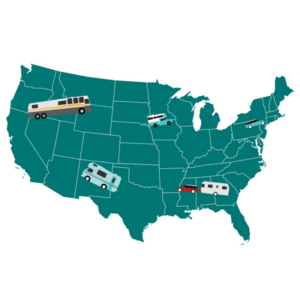 There are various reasons someone may want a mobile internet connection while in motion—including getting live traffic conditions, conducting work calls, passengers who work remotely, news, entertainment, and many others—and there are various ways to accomplish this.
There are various reasons someone may want a mobile internet connection while in motion—including getting live traffic conditions, conducting work calls, passengers who work remotely, news, entertainment, and many others—and there are various ways to accomplish this.
Cellular can make staying connected while driving on major interstates fairly easy. But nomads travel to many other locations where cellular reception can be much more spotty, and they might require other mobile internet options to keep them connected while in motion.
Many mobile internet set-ups use several sources to create versatile, redundant solutions for RVers and boaters. However, these are usually geared for use while parked, at the dock, or at anchor.
What else does it take to make these mobile internet solutions work in motion?
Can you use multiple cellular connections along with satellite while moving? What devices and tools do you need to make that happen? What about if you have a well-designed internet setup already, but it's in your trailer behind you and doesn't reach your tow vehicle very well? What if you're a family or couple that travels in separate vehicles but stays together?
If you don't already have a mobile internet solution, it's best to start planning your portable solution first, and then continue on in this guide for in-motion use.
For more information on mobile internet options for active nomads:
Do You Really Need Internet While In Motion?

Most people can get by with their smartphones for basic needs, but if you need more than that, you must first determine how important that option is to you.
What type of money and gear are you willing to invest in the solution? How much time and effort do you want to spend tweaking it to make it work for you?
Will you regularly conduct work calls while driving/cruising, and will it be a major issue if you experience drops? Or is it more of just wanting to stay connected for entertainment reasons?
Make sure you decide how important this is to you before investing in optimizing your mobile internet setup for in-motion use.
Another consideration is that working on a computer screen while in motion can cause motion sickness for some. And of course, if you are staring at a screen, you will miss the journey and scenery.
The simplest, cheapest solution for most is to make a stop at a location with a solid signal to do your most critical activities.
But if you are still reading this, you have probably decided that you need connectivity while in motion. Fortunately, there are consumer-accessible solutions for in-motion mobile internet connectivity.
Cellular for In Motion Internet Use
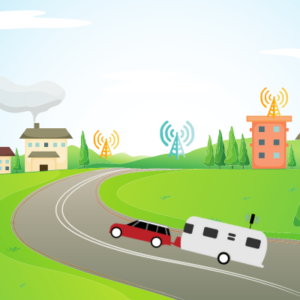
Using cellular in-motion is pretty common for most people, but your experience will depend a lot on the area of the country you are traveling to.
Some people who only travel around larger urban areas and cities may not realize the challenges those who like to travel in more sparsely populated areas of the country face with dead zones and dropped calls.
While interstates usually have good cell service, there certainly are exceptions in some areas. And once you get off the interstate in some locations, you may have dead spots between towers that could span many miles or more.
Signal Enhancing Tips
While using cellular connections, there are signal-enhancing tactics that you can use to help pull in those weaker signals and minimize drops and dead zones.
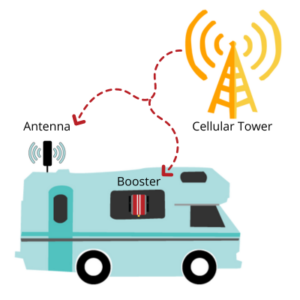
The most common option to start with is a roof-mounted omnidirectional antenna connected to an internal cellular router or hotspot, which is always there working for you and likely to give you the best cellular performance.
An omnidirectional antenna can pull in signals from any direction, so it is important that it has a clear 360-degree line of view to minimize dropouts as you move between towers.
The external antenna method only works on devices with antenna ports, which often limits it to higher-end routers and some hotspots.
Another option, especially if you don't have antenna ports, is a cellular booster.
A booster has an outside antenna to help it pull in weaker signals. These signals go through an amplifier, which then broadcasts the signal to any cellular device within range of its interior antenna.
A booster can definitely help extend your range and facilitate more seamless handoffs between towers. However, boosters will usually lower the overall speed if you are in a good signal area, so it's not always the best strategy.
For more information on signal enhancing, see our guides:
Optimizing & Understanding Cellular Data Performance
Starlink for In Motion Internet Use
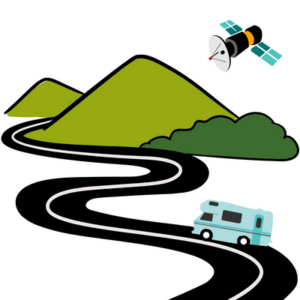
One of the more interesting options for your in-motion internet arsenal is Starlink.
Starlink works much differently than cellular in that it uses LEO (Low Earth Orbit) satellites flying overhead.
Starlink has a great advantage in that it works in remote locations where cell towers are just not practical. This makes it an awesome addition to your internet arsenal for staying connected in some of the most remote places.
Starlink does generally require a fairly open view of the sky to be reliable, and so it certainly has locations where it is not optimal. If you find yourself in heavy tree cover, passing under bridges or structures, or any obstacles blocking any part of the sky, you may find the subsequent drops to be quite frustrating.
Starlink is also congested in some areas of the country, mostly in more populated urban or suburban areas. Depending on your service plan, you could be at the lowest tier and suffer slower speeds while passing through heavily congested areas.
On the other hand, since cell towers tend to be much more sparse in unpopulated areas, Starlink can be a perfect complement to cellular-based internet in those locations.
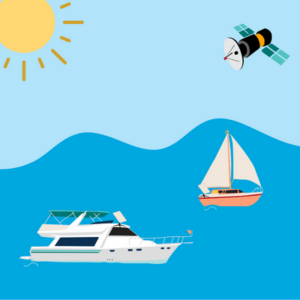
Of course, there are costs to adding Starlink if you intend to use it in motion.
Starlink only officially approves certain hardware for in-motion use. Check out our Starlink guide, linked below, for the current information on which Dish models support this feature.
Starlink also has different and frequently changing service plans with different in-motion terms and features. For high-speed in-motion use, you need a supported plan and/or opt-in to Mobile Priority data, which is an additional expense. Again, the specific details are in the guide linked below.
Another downside is that permanently mounting your Starlink dish on an RV or van makes it less flexible once you've stopped at a site. If the site is under trees, you may not be able to connect. By contrast, if you have a portable Starlink dish, you won't have in-motion usage but much more flexibility once you're stopped since you can place the dish in an optimal location away from your vehicle.
Like everything else related to mobile internet, it's about the tradeoffs you want to make.
For more information on Starlink:
Starlink Resource Center Starlink for RV or Boat Internet GuideBringing Multiple Connections Together
While having a great cellular connection or a reliable Starlink connection is great when it's working without interruption, there isn't a single solution that works 100% all the time.
Some cell carriers work better in certain areas than others, and connections can get glitchy when moving between towers.
Starlink works great when it has a clear view of the sky, but can suffer dropped connections if you find yourself in the trees or when something else blocks the signal.
This is where it becomes very important to have the redundancy of multiple connections. Or even better, to be able to immediately switch over to whichever connection is working the best right at that moment.
Redundancy of Options
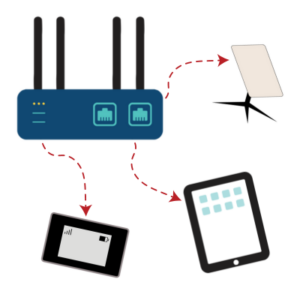
One of the best ways to accomplish this redundancy is to have a router that allows multiple internet sources to be brought into the same local area network so your devices use whatever is working best at the moment.
While basic failover or load-balancing is a step in the right direction, it doesn't eliminate interruptions completely, especially for a voice or video call that demands a consistent connection.
Bonding
And this is where bonding becomes the ultimate solution.
Bonding is an advanced technique that combines multiple internet connections into a single virtual connection. This connection has the potential to be both faster and substantially more reliable than any single connection alone.
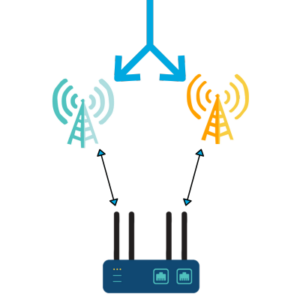
Bonding is a very powerful tool that allows two or more internet connections to be virtually bonded together, either through software running on the device or a service at a data center.
Combining those multiple sources into a single virtual connection can make your connection much more robust, giving you the most sturdy connection possible.
The bonding software is able to dynamically adjust how traffic is split across the various connections - detecting any errors and fixing them automatically. If one leg of the bond goes down or gets unreliable, the traffic will shift to the other legs seamlessly - and your connection will usually not miss a beat.
That's important when trying to keep a reliable connection while buzzing down the highway at 55 mph, where any one connection can go down at any moment.
Bonding can be accomplished on a dedicated router or, more simply, via an app or software on a computer, making it a flexible way to achieve robust redundancy on the move. In particular, if your primary router is in a trailer and too distant to reliably access via Wi-Fi, bonding smartphones and hotpots together in a vehicle via an app like Speedify can get you portable and simple reliability in your connection.
For more information on Bonding, see our guide:
Combining Internet Connections
Installation Considerations
Now that we know multiple internet sources can create a robust mobile internet setup, let's discuss where you might install your gear and some considerations for access while in the passenger seat. Here, we'll focus on the most common method: a setup that centralizes connections with a mobile router.
Where Is Your Router Located?
If you are traveling in a motorhome (Class A or Class C) or a smaller vehicle like a van, your router can likely provide a strong Wi-Fi signal almost anywhere in your rig.
However, if your internet gear is installed in a trailer you are towing or even a truck camper - you might not get a strong enough signal in the cab of your tow vehicle to stay online reliably.
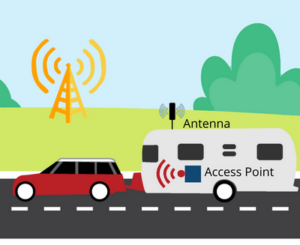
Between the metal frame of the tow vehicle and the distance to the router, you might find that the Wi-Fi signal in the cab of the truck is pretty weak and hard to stay connected to.
The first option is to consider installing your router as close to the front of your trailer as possible to create a stronger Wi-Fi signal in the tow vehicle.
But if that's not possible, what options do you have?
Depending on your trailer setup, one option is to put a Wi-Fi access point at the front of the trailer. Or perhaps hook up to an external Wi-Fi antenna on the roof of the RV that helps broadcast the Wi-Fi signal more strongly to reach the tow vehicle more easily.
You could even run a hardwired LAN connection between the truck and trailer with Ethernet, but that is probably unnecessary in most cases.
If all else fails, you might want to use portable devices like phones and hotspots in the tow vehicle while mobile or perhaps relocate your mobile router to the tow vehicle as a secondary install location.
Cellular Booster Location
If you are using a cellular booster, you might need to move the amplifier & antennas between the truck & the trailer or maybe have two antennas and move the amplifier unit itself.
For more information on installing your gear, see our guide:
Mobile Internet System Installation Considerations
Summary: In Motion Mobile Internet
Keeping connected while in motion can be a challenge, especially if you need a reliable connection to broadcast video or keep a remote desktop connection, but it can be possible with a lot of planning.
If you are just trying to keep passengers entertained with movies, stream a podcast, or keep your traffic info up to date -you may not have to go through extremes, and relying on portable devices like hotspots or the trusty smartphone works most of the time. But the more crucial your connection is to you, the more you should plan out your redundant setup to meet your needs.
Overall - redundancy, bonding, and placement are important considerations to keep you connected.
Explore the Resource Center
Have Questions?
Join our 'Library Desk':
Internet for RVers & Cruisers Facebook Group
We cross post news articles and guides, and can help point you in the right direction to our content here on the resource center.
It is with gratitude to our premium members that we're able to offer our free content - and for that, they also have access to our member Q&A areas for more in-depth guidance.
Become a Member
 The MIA is our premium membership - designed for those who consider mobile internet an important part of their lifestyle.
The MIA is our premium membership - designed for those who consider mobile internet an important part of their lifestyle.
In thanks for making content like this possible, we offer a bunch of additional perks. From interactive guidance, in-depth member exclusive content, discounts, alerts, classroom and ability to book private advising sessions.
Stay In the Know
We're constantly tracking the industry and analyzing new developments for mobile travelers. If you'd like to receive updates, we offer several ways:
- Subscribe to our free monthly newsletter
- Subscribe to our News Stories RSS Feed
- Subscribe to our YouTube Channel
- Follow our Facebook Page
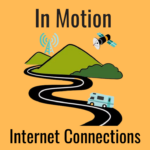
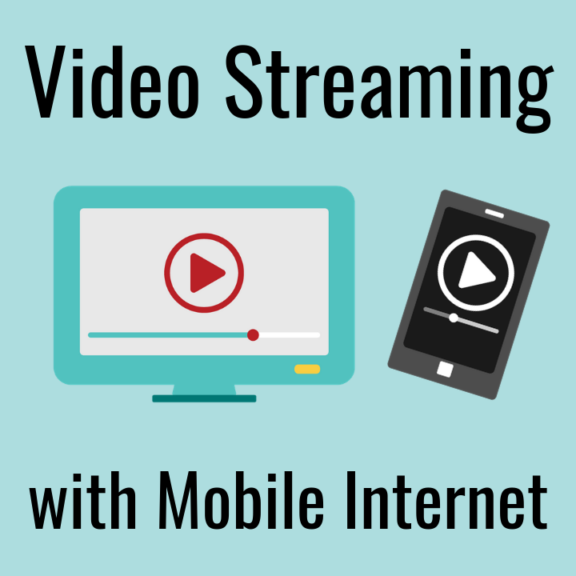
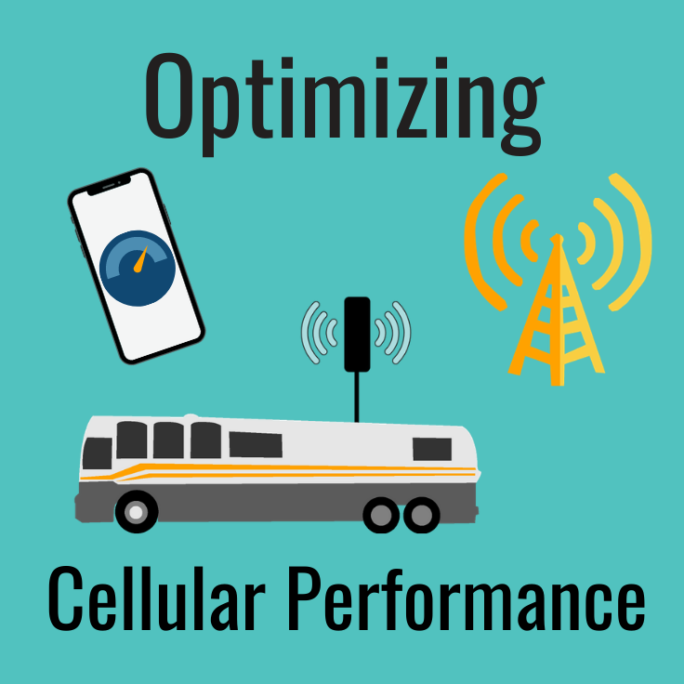
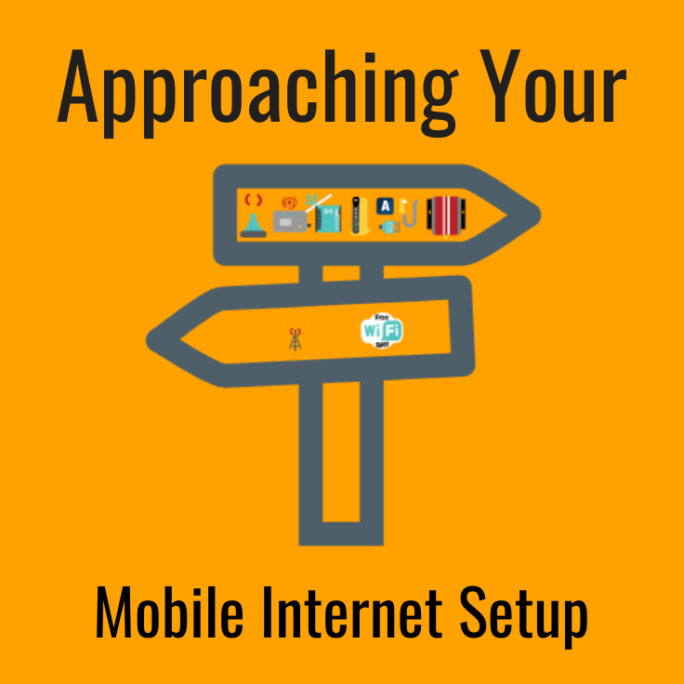
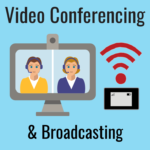

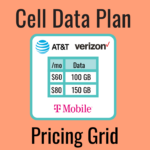
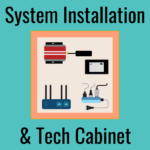
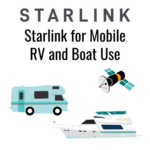
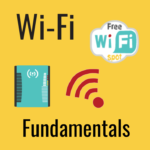
 Mobile Internet Resource Center (dba Two Steps Beyond LLC) is founded by Chris & Cherie of
Mobile Internet Resource Center (dba Two Steps Beyond LLC) is founded by Chris & Cherie of